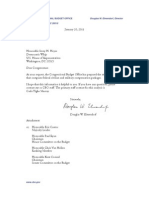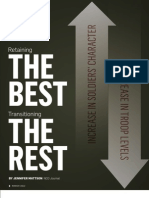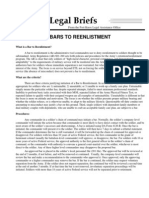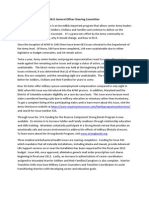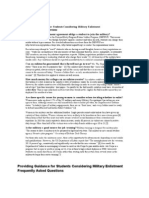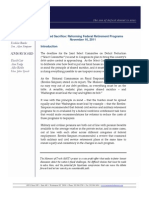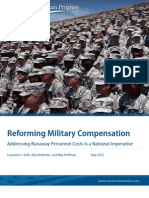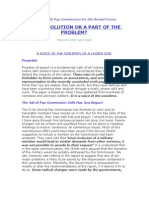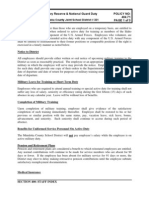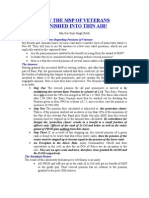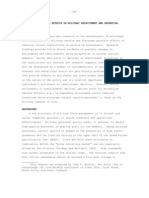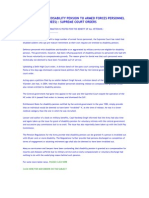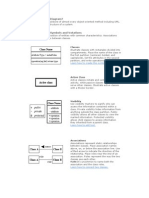Rehibilation
Rehibilation
Uploaded by
Sayed Saeed AhmadCopyright:
Available Formats
Rehibilation
Rehibilation
Uploaded by
Sayed Saeed AhmadOriginal Description:
Copyright
Available Formats
Share this document
Did you find this document useful?
Is this content inappropriate?
Copyright:
Available Formats
Rehibilation
Rehibilation
Uploaded by
Sayed Saeed AhmadCopyright:
Available Formats
RESTRICTED SC32/4441/Dissertation
A REVIEW ON REHABILITATION OF RETIRED SOLDIERS - BANGLADESH ARMY PERSPECTIVE
INTRODUCTION
1. Retirement is a natural process in any form of employment. A person goes on
retirement after serving in an organization according to organizational terms, norms and conditions. Army is no exception to that. However, the retirement age of army personnel are quite different from those of other organizations. In an average an army soldier, retire at the age ranging from 40-521 depending on their rank and promotion. Whereas their civilians counter part normally, retire at the age of 57 2 barring certain exception on special fields. With the increase of overall life expectancy at birth from 55.9 in 1990 to 68.3 in 2001 3, quite rationally, government is seriously considering whether to increase the retirement age to 60/62 years4 for government employees. Moreover, the civil employees have some options of being reemployed in same organization on a contractual basis after their retirement basing on their expertise and experience. But retired soldiers do not have any scope to serve in army on a contractual term. As such, army personnel enriched with large professional experience and specialized skill has at least 10-15 years of official serving age left at the time of retirement. 2. Every year approximately 40005 soldiers end their professional career through
regular retirement process. As a result, vast reserves of skilled, disciplined and committed human resource are made available in the country. Rehabilitation of such work force can help in achieving the dual task of offering veterans a meaningful second career, while simultaneously harnessing this invaluable resource towards nation building. Nevertheless, not all of them can be accommodated in civil society as employees whether in public or private sector. More over, the competitive job market makes the re-employment even more challenging and complex. More often, the retired army men would find them in a wrong footing about their qualification and experience to match with civil professionals. The state of their age also does no make them an attractive choice for the recruiting agencies. Self-
1 RESTRICTED
RESTRICTED employment remains as a better option for many of them. Army as an organization is expected to play a key role to ensure proper rehabilitation of its retired men. 3. Rehabilitation process needs to start at least 3 to 12 months before retirement and
should continue until the time a smooth transition of ones life is achieved from military to civilian life. At present army is providing pre-release training for 3-6 months duration to its men on different fields, which include technical training, poultry, textile, driving and so on. Post retirement facilities like pension, medical, ration are provided as part of rehabilitation process. Limited re-employment opportunities are also offered, mostly in different army welfare organizations on contractual basis. Skilled Technical Manpower to Kuwait offers reemployment option to soldiers having specialized skill. However, comparing to the huge retired personnel, it is certainly not enough. 4. It is understood that rehabilitation of retired men will not only facilitate them to have
a dignified life but also motivate the future generation to join army. Self-employment by providing job oriented training and necessary financial support can ease the process to a greater extent. Scope of study in this paper will be confined to rehabilitation in terms of reemployment and self-employment only. At the beginning of the paper, an analysis will be made to find out whether rehabilitation for retired army men is a necessity or option. Primary datas collected by conducting a survey on serving soldiers about their financial and family status will be the basis of the analysis. Next step would be to carry out an in depth study on current rehabilitation programmes undertaken by army for its retired men. Main objective will be to identify the weakness of the existing system in order to cope with present challenges. In this connection, the rehabilitation system of armies of contemporary countries will be examined to draw lessons from that. In light of preceding discussions, few viable options for generating more re-employment opportunities will be highlighted. At the same time, feasible means and ways for creating avenues for self-employment of retired soldiers will be discussed. Primary data collected through survey will be basis of analysis and secondary data will be used to complement the arguments. AIM 5. The aim of this paper is to analyze the existing rehabilitation system for retired army men with a view to suggesting viable re-employment and self-employment options to meet the challenges. 2 RESTRICTED
RESTRICTED REHABILITION OF EX-SERVICEMEN: NECESSITY OR OPTION 6. The main argument under this heading would be to reach a conclusive finding of
whether rehabilitation is a requirement or merely an option. In doing so, the existing retirement policy and post retirement benefit that a soldier receives from army would be studied in detail. A survey6 was carried out on soldiers of three age groups (30-35, 35-40 and 40-45 age groups) in this connection. The objective of the survey was to draw a common pattern of family structure of a soldier at the time of retirement vis a vis his financial capacity to maintain that family. The financial load in comparison to income generating capacity (including the post retirement benefits) of retired soldier will be the yardstick to conclude whether rehabilitation is a requirement or an option. 7. Expected Age of Retirement for Army Personnel. A soldier can serve between 21-
337 years depending on his promotion. The eligible age for joining army as a soldier ranges between 16 and 198 years. Taking 19 years as an average recruitment age and considering normal retirement (excluding volunteer, force or premature retirement), the expected retirement age of soldiers for different service length are shown in Figure-1.
Figure-1 Expected Age of Retirement of Soldiers (in Years)
40
41
42
43
46
48
52
21 Private
22
23 Corporal
24
27 Warrant Officer
29
33
Service Length
Master Warrant Officer Expected Age of Retirement
Source: Bangladesh Army Order Number 288/88
3 RESTRICTED
RESTRICTED 8. Post retirement Benefit Received by a Soldier. As per the present Government
regulations9, retired soldiers are entitled with certain privileges (pension, leave, medical and ration) from the service. a. Pension. A soldier after serving minimum 1510 years and above is entitled to receive pension after retirement. The exact amount of pension varies as per rank, qualification and service length of an individual. A soldier receives approximately taka 3900 per month as pension if he retires at the rank of private. Whereas, same soldier would be receiving an amount of taka 6600 pension per month if he retires as a master warrant officer. An approximate pension benefit received by soldiers at different rank is shown in table-1.
Table-1 Pension Received by Soldiers
Serial Rank Basic Salary on Pension last 1. 2. 3. 4. 5. 6. Private Lance Corporal Corporal Sergeant Warrant Officer Senior Warrant 7. Officer Master Warrant Officer 7880 6592 Same as above Year of in Taka 3908 5180 5490 5853 6180 6348 (last salary+360) x service length/31 Same as above Same as above Same as above Not more than 80% of (last drawn salary+360) Same as above service in Taka 5410 6940 7040 7200 7365 7575 Remarks
Source: Based on Joint Services Instruction (JSI) 10/2005- Part3
b. Medical and Ration. Retired soldiers are entitled to receive taka 4 RESTRICTED 50011 medical allowances each month. In addition to that they also receive taka 137
RESTRICTED ration allowance12 for service length under 12 years and taka 247 for service length above 12 years. 9. Family Structure of Soldiers. The official marriageable age for a soldier is
2413 years. He usually starts his family life between 24 and 28 years. Generally, he is the only earning member in his family. His family constitutes of children, wife and parents. However, in this study wife and children up to 18 years of age are considered dependent. The result of the survey can be summarized as follows: a. For Soldiers within 30 to 35 Years Age Group. Soldiers belonging to this
age group generally have children aging below 6 years. At least one child in a family is observed to be school going. Most of the soldiers found to have three dependents in the family. Findings of the survey are shown in Figure-2.
Figure-2 Family Structure of Soldiers (Within 30 to 35 Years Age Group)
Children of Different Age Groups
Number of Dependents
0% 38%
25%
12%
62% 63%
0-6 Age Group 12-18 Age Group
6-12 Age Group
Wife and 3 Children Wife and 1 Child
Wife and 2 Children
Source: Survey Conducted by Author
b. For Soldiers within 35 to 40 Years Age Group. Soldiers belonging to this
age group generally have children aging between 6-12 years. Majority of the
5 RESTRICTED
RESTRICTED Children are observed to be school going. Most of the soldiers found to have three dependents in the family. Findings of the survey are shown in Figure-3.
Figure-3 Family Structure of Soldiers (Within 35 to 40 Years Age Group)
Children of Different Age Groups
Number of Dependents
11%
25%
26%
22%
64% Wife and 3 Children 0-6 Age Group 6-12 Age Group 12-18 Age Group Wife and 1 Child
52%
Wife and 2 Children
Source: Survey Conducted by Author
c. For Soldiers within 40 to 45 Years Age Group. Soldiers belonging to this age group generally have children aging between 12-18 years. Children are observed to be both school and college going. Most of the soldiers found to have three dependents in the family. Findings of the survey are shown in Figure-4.
Figure-4 Family Structure of Soldiers (Within 40 to 45 Years Age Group)
Children of Different Age Groups
NUmber of Dependents
7% 38%
16%
23%
55%
61%
Wife and 3 Children 0-6 Age Group 6-12 Age Group 12-18 Age Group Wife and 1 Child
Wife and 2 Children
Source: Survey Conducted by Author
10. Survey on Financial Status of Soldiers. The financial aspects of the soldiers families are generally shouldered and run by the soldiers themselves. Apart from the salary 6 RESTRICTED
RESTRICTED received from army, soldiers usually have other source (House rent, Small business, Farming etc) of income. Income generated from those sources are found to be less than taka 1000 per month for most of the soldiers. Detail of the findings is shown in Figure-5.
Figure-5 Income Generating Capacity of Soldiers (Having 15-25 Years Service Length)
11% 20% 51% 18%
Below 1000
1000-2000
2000-3000
Above 3000
Source: Survey Conducted by Author
11. Summary of the Findings. The findings from the above study can be summarized as a. b. c. A soldier retires within the age range of 40-52 years having 21-33 years of The pension benefit ranges from taka 4600-7400 per month depending on Approximately sixty percent of the soldiers have three dependents in their
follows: service. rank and service length. family at the time of retirement out of which 50 percent are within 6-12 years age groups and 38 percent are within 12-18 years age groups. d. 12. Income other than salary for 51 percent of the soldiers is less than taka 1000. A soldier at the age of retirement remains physically fit to undertake
Comments.
second profession. His family status clearly indicates that he is potentially the only earning member in his family at that time. In an average, a soldier during his time of retirement has 7 RESTRICTED
RESTRICTED 3-4 dependents in his family with 2-3 school and college-going children with increasing economic pressure. His post retirement benefits are certainly not enough to bear the family expenditure in the present social context. Therefore, a conclusion in this regard can be drawn that rehabilitation of army personnel after retirement is a requirement. EXISTING REHABILITATION SYSTEM IN BANGLADESH ARMY Organizational Set up and Programmes Undertaken by Army 13. Organization and Function14. Welfare and Rehabilitation (W&R) Directorate,
under Adjutant Generals (AG) Branch of the Army Headquarters, looks after the rehabilitation and welfare aspects of retired army officers and soldiers. The directorate has four sections namely Welfare, Rehabilitation, Project and Account Section. Rehabilitation section is responsible for organizing and supervising the rehabilitation programme for exservicemen undertaken by the Army. In doing so, it performs the following specific functions: a. b. c. Arrange pre-release training for interested Junior Commissioned Officers Assist ex-servicemen in getting civil employment and process their Process permission of officers who intend to run independent business or seek (JCO) and Other Ranks (OR) before going on retirement. applications for clearance for serving aboard. employment in civilian firm/establishment during Leave Prior to Retirement. 14. Pre- Release Training. The section runs pre-release training of 2815 courses in
25 different organizations for interested JCOs and ORs of the army. Duration of the course varies from three to 6 months 16. Field of pre-release training includes technical training, poultry, textile, driving etc. A list of pre-release training is given at Annex A. Army has so far spent taka 31.55 lakh as pre-release training expenditure from 1997 till 2006 with an average expenditure of taka 3.15 lakh per year17. Summary of last ten years expenditure on pre-release training is shown at Annex B. From 1997-2006, 449718 servicemen (353 JCOs and 4144 ORs) completed pre-release training. Number of persons availing pre-release training is approximately 8.9 percent of the total retirees. Summary of last ten years statement of manpower underwent pre-release training is shown at Annex C.
8 RESTRICTED
RESTRICTED 15. Re-employment. Rehabilitation section maintains a data bank19 where detail
particulars of retired persons are kept to facilitate re-employment. It publishes periodical advertisements in the newspapers highlighting the availability of ex-servicemen with specific qualification. In response to the employment opportunities offered by the civilian organizations, this section act as a coordinator to facilitate re-employment of retired personnel. Such list is regularly updated. So far, a total of 80 Officers, 11 JCOs and 63 ORs have been employed. Summary of employment of retired personnel are given at Annex D. Skilled Technical Manpower to Kuwait (STMK) 20/ Mehni Project 16. The participation of Bangladesh Army in operation Desert Storm in 1991 opened
the door for exporting skilled retired armed forces personnel in Kuwait. A Memorandum of Understanding (MOU) was signed for 5 years on 15 December 1992 to send skilled manpower to Kuwait. The agreement was renewed time to time and currently a protocol of 6 years term is running since 2004. The terms of the agreement were extended with the inclusion of Mehni project in year 2004. Selected candidate will be released from the existing service as per Army Regulation (I) 171(j) 1948 before proceeding to Kuwait. Percentage of vacancies is allotted to three services in order of Army 75%, Navy 12.5% and Air Force 12.5%. 17. State of Employment in STMK/Mehni Project. So far 3838 army personnel
participated in STMK and Mehni project. From the above-mentioned figure, 2184 army personnel so far completed the assignment. Details of manpower state so far completed the assignment is given in Annex E. Presently 1654 personnel are working in STMK and Mehni project. Details of present employment state are given in Annex F. 18. Pay and Allowances. Skilled personnel employed in Kuwait under STMK/Mehni
project will receive salary as per ranks shown in table-2.
Table-2 Pay and Allowances of STMK/Mehni Project
9 RESTRICTED
RESTRICTED Ser 1 2 3 4 5 Rank Sergeant Corporal Lance Corporal Private Mehni Salary (in KD) 191.00 171.00 156.00 144.00 100.00
Source: STMK Cell Brief-2007 Prepared for Chief Liaison Officer
Sena Kallyan Songstha (SKS) 19. SKS21 is an autonomous business organization running on self-sustaining basis and
channeling lion share of its profit into welfare for its beneficiaries. The vision of SKS is to serve the entire community of the retired armed forces personnel by generating maximum profit through commercial ventures. At present SKS fully owns 11 industrial and 3 commercial units. In addition, it owns four Sales Promotion Office, 24 Real Estates and shareholding in six internationally reputed enterprises. 20. Keeping that vision in mind, SKS extends its welfare activities in the form of
Educational stipend/grant, Stipend/grant for training, Medical treatment, financial assistance to the distressed widows and Rest house for ex-servicemen. Between 2001- February 2006 SKS has spent taka 10.93 crore for educational stipend, taka 4.59 crore for medical treatment taka 1.97 crore for training and other welfare. It provides limited employment opportunities to its beneficiaries. Bangladesh Arms and Services Board 21. Bangladesh Arms and Services Board (BASB) 22 is a welfare-oriented organization.
BASB is an establishment under Ministry of Defence. However, Armed Forces Division and Headquarters Logistics Area exercise some controls relating to financial and administrative aspects. BASB operates all over the country having 20 branches stationed in 19 different old districts towns. However, it is supposed to have its braches in all district towns. 22. It performs three broad tasks in practice. These are as follows: a. It carries out on ground verification on police, legal and welfare related 10 RESTRICTED matters as per the request of various offices.
RESTRICTED b. c. It provides limited administrative and medical support to ex-servicemen in It also provides limited financial assistance to ex-servicemen and assists the
coordination with local administration. activities of SKS. REHABILITATION SYSTEM OF CONTEMPORARY ARMIES Rehabilitation in Indian Army23 23. Organizational Setup. In Indian Armed Forces, central and state governments for resettlement and welfare of ex-Servicemen. Ex-
share the joint responsibility
Servicemen (ESM) Welfare Wing of the Ministry of Defence is responsible for the formulation of the policy guidelines and schemes for resettlement of ex-Servicemen. Two Inter Services Organizations, Directorate General of Resettlement (DGR) and Kendriya Sainik Board (KSB), assist the Department. The KSB/DGR is also assisted by various Rajya Sainik Boards/Zila Sainik Boards, which are under the administrative control of respective state governments. 24. Training Programme. Resettlement Training Programmes for JCOs / ORs and
their equivalent from the other services are conducted in diversified fields for duration of up to one year in various institutes. The table below shows the state of resettlement training for Person Below Officer Rank (PBOR) and ESM.
Table-3 State of Resettlement Training in Indian Army (up to January 2006)
SCHEME PBOR Training ESM Training 2001-02 3518 421 2002-03 2958 856 2003-04 4019 1102 2004-05 3016 1102 2005-06 4395 843
11 RESTRICTED
RESTRICTED
Source: www.mod.nic.in/welfareschemes
25. Re-employment. The Central and state governments provide a number of
concessions like reservation of posts/relaxation in age and educational qualifications to exservicemen for their re-employment in Central/state government posts. The details of exservicemen who have been provided employment through DGR is shown in chart-6.
Figure-6 State of Re-employment of Ex Service Men by DGR
12000 10000 8000 6000 4000 2000 0 2001 2002 2003 2004 2005
Central Govt
State Govt
Private Sector
Security Agencies
Source: www.mod.nic.in/welfareschemes
26. Schemes for Self-employment. Indian Government has formulated several schemes for encouraging and giving financial support by way of loans to ex-servicemen entrepreneurs intending to set up small and medium industries. Major self-employment schemes are SEMFEX-II, SEMFEX-III and National Equity Fund Scheme. In addition, DGR sponsors ESM Coal Transport Companies for providing loading and transportation of coal in various coal subsidiaries of Coal India Limited (CIL). JCOs and ORs are allotted Mother Dairy Milk shops and fruit & vegetable shops in the National Capital Region. Rehabilitation in Pakistan Army 27. Organizational Setup. In Pakistan24 Army, W & R Directorate is responsible
for looking after the welfare and rehabilitation of the retired officers. It works under General 12 RESTRICTED
RESTRICTED Headquarters (GHQ) in coordination with Army Welfare Trust (AWT) and Fauji Foundation. AWT usually generate money and provide employment to retired personnel in own industries. Fauji Foundation also generates fund for W&R facilities to retired personnel. 28. Fauji Foundation. Spending more than Rs. 21 billion since inception on welfare,
the Foundation provides services in the areas of healthcare, education, educational stipends, technical and vocational training. Presently 9 Technical Training Centre and 66 Vocational Training Centers are imparting training in basic skills to ex-servicemen and their wives and daughters. Projects undertaken by Fauji Foundation for re-employment are Overseas Employment Service (OES) and Fauji Security Service (FSS). OES has so far been sent 7663 individuals abroad since inception in 1978. Rehabilitation in Singapore Army25 29. Singapore Army follows a unique way to rehabilitate retired soldiers in civil society.
Rehabilitation process starts right from the beginning of a soldiers military career. Military units in Singapore have four training cycles. Four cycles comprises of professional training, administration, leave and nation building. As part of nation building cycle, soldiers work in different industries for three months as per their skill and choice. 30. During the nation building cycle, a soldier receives remuneration from the concerned
industry apart from his salary from the army. Certificate is awarded to each soldier that adds a new qualification in his career. Thereby, a soldier can easily be reemployed after his retirement by the same industries.
WEAKNESS OF EXISTING SYSTEM A COMPARATIVE STUDY 31. Present State of Re-employment. The trade or employment structure of the Army,
broadly, has two groups namely, the General Duties (GD) and Skilled or Technician groups. Soldiers from Engineers, Signals, Army Medical Corps (AMC), Electrical and Mechanical Corps (EME) and Army Clerical Corps are considered to be skilled manpower. Soldiers from remaining arms and services are considered as GD group. From 2000-2004, 19259 26 (with an average of 3851 soldiers per year) soldiers retired from service. The ratio between 13 RESTRICTED
RESTRICTED skilled and unskilled manpower retiring each year is 23% and 77% respectively. Detail of Arms and Service wise retirement per year is shown Annex G. Where as, in Indian and Pakistan Army in average 5500027 and 3000028 soldiers retire per year respectively. According to last five years statistics, soldiers reemployed in various organizations are 9.5 percent of the total retiree. Percentage of re-employment in Indian and Pakistan Army is approximately 20 percent and 16 percent of the total retiree respectively. However, higher percentage in terms of re-employment may be achieved but re-employment of all retirees may not be possible due to unemployment problem prevailing in the country. 32. Lack of Educational Training. The entry-level academic qualification for
soldiers is Bangladesh Army is SSC29. Indian and Pakistan Army also have similar academic qualification for soldiers. Soldiers in Pakistan Army can pursue higher study under organizational arrangement30. Station Central School conduct classes for HSC and graduation level students and thereafter a soldier can appear examination under education board of respective areas. Similar educational training is imparted in Bangladesh Navy 31. Sailors appear Lower Educational Test (SSC equivalent) and Higher Educational Test (HSC equivalent) under the arrangement of navy and certificate is awarded by the education board. More so, the Technical Education Board of Bangladesh awards diploma certificate to the sailors undergoing any specialized training on technical aspects. However, in Bangladesh Army, soldiers can only pursue private study with due permission from appropriate authority. No initiative is taken by army to educate the soldiers on higher studies. 33. Lack of Integrated Effort at National Level. Rehabilitation programme in
Indian Army is coordinated at national level integrating both central and states government. Clear policy guidelines are set by MOD, which is executed by DGR and KSB. Fauji Foundation shares the main responsibility in consultation with national executive body in Pakistan Army. It is the case with Singapore Army also. But in Bangladesh Army, W&R Directorate at AHQ is the only branch that deals with rehabilitation of retired soldiers. Civil Military Relation (CMR) Directorate at Armed Forces Division deals with officers reemployment only. Resettlement of retired soldiers is not even included as a responsibility in the allocation of business32 of MOD and AFD. Absence of a clear policy guideline and coordinating agency at national and AFD level essentially narrows down the scope of rehabilitation of retired soldiers.
14 RESTRICTED
RESTRICTED 34. Lack of Objectivity and Inadequacy of Pre-release Training. Singapore Army
clearly stands ahead in terms of preparing the soldiers for employment after the end of military career. Fields of pre-release training like Security Services, Management, Information Technology, Entrepreneurship & Small Business Management provided by Indian Army certainly provides better scope for re-employment. On the contrary, in Bangladesh Army courses selected for pre-release training definitely leaves a question mark in terms of its employment prospects. Courses33 like heat surface treatment, Bench Fitting, First Aid, AC motor welding, Socks knitting; Basic Driving may not fulfill the desired objective of self-employment. In Indian Army DGR34 constantly monitor existing courses and training standard of empanelled institution. Such monitoring system neither exists nor is any feedback taken from the trainees about the standard of empanelled institution in Bangladesh Army. 35. Absence of Self-employment Scheme. It may not be feasible to provide
employment to all soldiers after their retirement. In most cases, soldiers intend to settle down in their home district after retirement. Army needs to formulate suitable schemes for encouraging and giving financial assistance by way of loans to ex-servicemen intending to set up small and medium agro based firms and small businesses. Indian Army has such schemes35 under which ex-servicemen are assisted to set up agro/food processing units, small-scale cottage industries in rural areas by providing loan and technical assistance. In both India and Pakistan, a good number of officially enlisted organizations, cooperative societies of ex-servicemen are available which provide a better platform for selfemployment. No such officially recognized organization of ex-servicemen exists in our country. There are few societies of retired soldiers at local level, but not operating as a business entity. 36. Lack of Public Awareness. The need for rehabilitating of ex service men is
strongly felt by the leaders at national level in India. To create public awareness special television programmes are telecasted and journals are published periodically. DGR in Indian Army have sensitized the civil industry and business houses through various seminars 36. Objective of such awareness activities is to keep all segment of private and public sectors informed about the vast and untapped Human Resource potential available in armed forces. On the contrary, very limited activities are organized in Bangladesh Army to create public
15 RESTRICTED
RESTRICTED awareness. In reality, private organizations consider armed forces personnel merely to be disciplined, but not aware of their skill and expertise on various fields. 37. Lack of Policy and Vision. Indian Government under National Common Minimum
Programme (NCMP)37 has set up ESM Welfare Wing under MOD to focus attention on the rehabilitation of ESM. Responsibilities of Central and State governments are clearly spelled out to have synergy in the rehabilitation effort. Reservation of quotas in government job, self-employment scheme like Self-employment for Ex-servicemen (SEMFEX) -II38, SEMFEX-III39 and National Equity Fund Scheme (NEF)40 has boosted the rehabilitation process. On the other hand, in Bangladesh Army no clear vision exists about the rehabilitation of retired soldiers at any level. As such, no clear policy has also been formulated so far. As a result, rehabilitation effort is mostly done in isolation and as and when needed basis. Policy makers at higher echelon have to realize the need for an effective rehabilitation system for the betterment of the organization. APPROACH TO OPTIMIZE THE REHABILITATION EFFORT Thoughts and Minds of Soldiers 38. Before any measures is suggested it imperative to know the need of the target group.
A survey was carried out to know the plan of soldiers after retirement. Two target groups were selected for the survey. Skilled soldiers from Corps of Engineers belong to first target group and GD soldiers from Infantry belong to second target group. Result of the survey is shown in Figure-7.
Figure-7 Soldiers Preferred Options for Employment after Retirement
16 RESTRICTED
RESTRICTED
Skilled Group
General Duty Group
10% 28% 62% 42%
14%
44%
Look for a New Job Setting up Agro Based Farm
Setting up Small Business
Look for a New Job Setting up Agro Based Farm
Setting up Small Business
Source: Survey Conducted by Author
39. Same target groups were asked as to how they want army to assist them after retirement. Again, the response from both the target group was quite different from each other. Response from both target groups is shown in Figure-8.
Figure-8 Nature of Assistance Opted by Soldiers from Army
Skilled Group
General Duty Group
10% 20%
6%
14%
70%
80%
Provide New Job Training on Farming and Business Loan from Bank
Provide New Job Training on Farming and Business Loan from Bank
Source: Survey Conducted by Author
40. Comments. From the preceding survey, result it may be concluded that skilled
manpower group due to their technical skill is more confident in finding a job after retirement. On the contrary, GD group stressed upon the need to have pre-release training for rehabilitation. 42 percent of the soldiers from GD group were interested to set up agro based 17 RESTRICTED
RESTRICTED firming after retirement. Considerable percentages from both groups were interested to set up small business at their own. Since 77 percent of the soldiers are from GD group, rehabilitation may be oriented for creating more opportunities self-employment rather that re-employment. Revitalization of Present Rehabilitation System 41. Introduction of Formal Educational Training41. Soldiers generally come from
lower middle class family42 having village background. Quality of education received by soldiers from schools in rural areas is not of satisfactory standard. Therefore, it is imperative for them to pursue higher study for finding a better second career after retirement. It is possible to provide educational training to the soldiers up to HSC43 level with the existing instructor and infrastructure facilities available in Station Central School. The training should be aimed at achieving HSC level qualification for all soldiers within first 15 years of service. Thereby remaining years of his career can be planned for imparting specialized training aiming at rehabilitating him in civil society. Example can be drawn from Pakistan Army and Bangladesh Navy. Tutorial classes may be conducted for three months duration in Station Central School. Affiliation may be requested from the education board of respective formation. However, the proposed University of Professionals 44 will provide better platform for such educational training. 42. Organizational Reform. Rehabilitation in terms of re-employment or self-
employment is only looked after by rehabilitation section under W&R Directorate at AHQ. The effort and output of that section is not also very heartening. To ensure meaningful rehabilitation an effective organizational set up is necessary. At MOD level, under General Wing a separate section may be opened namely Resettlement Section which would primarily act as a coordinating agency between armed forces and other ministries of the government on issues related to resettlement. At AFD level, under CMR Directorate a separate resettlement section may be established headed by a lieutenant colonel. At unit level, Commanding Officer must take the responsibility in preparing his men for Resettlement after Service. Encouraging soldiers to pursue higher studies, motivation and guidance to select appropriate resettlement training course is certainly a command responsibility. Target oriented task45 can be assigned to Rehabilitation Section at all level.
18 RESTRICTED
RESTRICTED 43. Objective Oriented Pre-release Training. Pre-release training should be imparted
on those fields where employment prospect is high. Separate training may be focused for skilled and unskilled group. For unskilled group training on agro based firming, Entrepreneurship & Small Business Management, Security Management and Travel & Tourism including Adventure Tourism are few suitable options. For skilled group training on Information Technology, Secretarial Management, Small workshop Management, Transport Service Management are few viable options. Bangladesh machine tools factory (BMTF) can be utilized for imparting on job training46. W&R directorate should make periodical inspection to the training institutions to assess their suitability. 44. Proactive Rather than Reactive Attitude. Job market is highly competitive in our
society. Close interaction and better affiliation is needed with the business community to generate more employment opportunities for retired soldiers. Efforts should be made by the W&R Directorate to make concerned people aware of the youthful age, qualification and skill offered by the retired army soldiers through wide publicity. It may include: distribution of booklets and brochures, inviting head of the different private organizations in army occasions, routine visit by W&R Directorate to various multinational companies, periodical advertisement in electronic and print media, and liaison with other government offices where from regular assistance is required. 45. Formulation of Policy. Rehabilitation of ex-servicemen is not a challenge that
can be met overnight. It is a long-term process, which needs to be duly supported by long, dynamic and pragmatic vision. Absence of such vision has lead to a disintegrated effort by the welfare organizations having no specific goal to achieve. A clear policy needs to be in place for the rehabilitation of retired army men. Integrated efforts by all national and organizational agencies can only make the rehabilitation process meaningful and effective.
Potential Sectors for Re-employment 46. Security Service. The long and rich experience of armed forces personnel on
security matters makes them forerunner in any assignment related to security service. Both 19 RESTRICTED
RESTRICTED in India and Pakistan security service organize by ex service men have earned its credential in public and private sectors. Similar projects can be organized and financed by SKS. By that, a good number of employment opportunities can be generated. Soldiers from GD group are better suited for assignment related to security service. 47. Foreign Employment. In recent time, manpower export to Malaysia has been
suspended for indefinite period47. While describing reasons for such step, Home Minister Datuk Seri Mohd Radzi Sheikh Ahmad said, Besides problems related to the agents, the workers themselves were causing many social woes48. In this pretext, to restore the credibility and prove the expertise of our Human Resources, retired soldiers may be sent as part of manpower export projects undertaken by the government. Retired soldiers from Engineers, EME, Signals and AMC can perform the duty of skilled labours like drivers, special vehicle operator, mechanics, medical assistant, painter, welder, computer programmer, operator etc. Their experience in serving as a peacekeeper combined with skill make them the best choice for any foreign assignment. 48. Transport Sector. Among the utility services taxi cab service is certainly very
promising. But poor management, ill-trained drivers, poor quality service and insecurity has lowered the potential of this sector. Remedies to all the problems are perhaps available in employing retired drivers of Army. Transport agency can be setup by retired army personnel having an efficient management run by retired officers. Retired soldiers of Mechanical Transport (MT) Trade with their long driving experience can surely provide safe and quality service. 49. Compressed Natural Gas (CNG) Conversion and Maintenance Workshop. CNG
conversion and maintenance workshops have excellent business potential now a day. Such workshops can be set up by SKS and run by the retired soldiers from EME Corps due to their technical expertise. Besides, same skilled group can be organized to run maintenance workshop for private and public transports. Policy can be formulated so that government transport may be repaired and maintained in such workshops. Self-employment - Means and Ways 50. Self-employment Scheme. It is a reality that not all the retired men can be
reemployed despite every efforts taken by army. Besides, majority of the soldiers, having 20 RESTRICTED
RESTRICTED stayed away from their families during their service, prefer to settle close to their homes in rural areas. Self-employment schemes may be introduced to provide a comprehensive package of credit for encouraging retired soldiers to undertake agricultural and allied activities or to set up non-farm units in rural. Bangladesh Krisi Bank, being a specialized bank in this sector, may be explored to offer special micro credit projects/programmes for retired soldiers. Trust bank, being the welfare organizations of armed forces, can also be utilized. Cooperative societies49 can be organized at district levels, which will act as platform for the retired soldiers for opening up avenues for self-employment. This society will coordinate with bank for sanctioning and paying back loan, arranging meetings for the members, interface with specialist on various fields and act as a bargaining power in bulk purchase of inputs and marketing of their products. 51. Setting up Small Business. In rural areas, retired soldiers may set up small
business like cold storage, food storehouses, rice mills, pharmacy and departmental store. Pre-release training on Entrepreneurship & Small Business Management can prove effective in this regard. Soldiers from electrical and mechanical engineering can set up small and medium workshop due to their wide experience on technical matters. Necessary monetary assistance may be provided from Army Trust Bank. 52. Agro Based Farming. Agro based farming is a viable alternative for the re-
employment of soldiers which is also one of their preferred options. Farming activities may include fisheries, poultry, plantation, and crop and vegetables production. Cooperative society by the retired soldiers can explore attractive farming avenues specific to a region of the country. A hypothetical model of an agro-based firm run by the retired soldiers cooperative society is developed in Annex H.
CONCLUSION
53. To maintain a war worthy youthful profile for army, every year a substantial number 21 RESTRICTED
of soldiers retire at a comparatively young age. By the time a soldier retires, he has still 10-
RESTRICTED 15 years of official serving age left and a sizeable family to look after. On the contrary, post retirement benefit like pension, medical and ration provided by government are certainly not enough to bear the expenditure of his family in present social context. Looking for a new job becomes compulsion for him. However, soldiers often find it difficult to manage a job conforming to his last status/last salary drawn. His ability to maintain the livelihood for this family is challenged by the hard reality. 54. Army is expected to play a key role in rehabilitating its men after retirement. W&R
Directorate, under AGs Branch of AHQ, looks after the rehabilitation and welfare aspects of retired soldiers. Rehabilitation section of W&R Directorate arranges pre-release training for interested soldiers before retirement. Fields of training include technical training, poultry, textile, driving etc. Rehabilitation section also maintains a data bank where detail particulars of retired persons are kept to facilitate re-employment. So far, 64 soldiers have been reemployed in different organizations. Moreover, STMK/Mehni projects opened a new avenue to export skilled manpower to Kuwait. Since December 1992, so far 3838 army personnel participated in STMK and Mehni project. SKS, being an army welfare organization, runs with the aim of serving the entire community of the retired armed forces personnel by generating maximum profit through commercial ventures. Between 2001- February 2006 SKS has spent taka 10.93 crore for educational stipend, taka 4.59 crore for medical treatment taka 1.97 crore for training and other welfare. It also provides limited employment opportunities to its beneficiaries. BASB is another welfare organization, which provides limited administrative, medical and financial assistance to ex-servicemen. 55. Surprisingly, there is no clear policy guideline and as such, no future strategy has so
far been worked out on rehabilitation issues. Lack of coordination among the welfare organizations and absence of target-oriented task has essentially slowed down the rehabilitation effort. Consequently, in an average only 9.5 percent of the total retirees are re-employed each year. No scheme has so far been formulated for giving financial support by way of loans to ex-servicemen to set up small farm or business to earn their livelihood. More so, courses selected for pre-release training definitely leaves a question mark in terms of its employment prospects. Where as Indian and Pakistan Army has noticeably stepped up their effort in rehabilitating ex-servicemen. Rehabilitation programme in Indian Army is coordinated at national level integrating both central and states government. The Central and state governments provide a number of concessions like reservation of posts/relaxation in 22 RESTRICTED
RESTRICTED age and educational qualifications, exemption of fees to ex-servicemen for their reemployment. In Pakistan Army, Fauji foundation is imparting training in basic skills to exservicemen and their wives and daughters. Projects like OES and FSS provide employment opportunities to ex-servicemen in Pakistan. 56. Fortunately, Bangladesh Army has all the infrastructure facilities in place to
undertake a meaningful rehabilitation effort for its men. What is most needed at this time is the revitalization of existing system. A clear policy needs to be in place so that all welfare organizations can function under a broad framework to achieve a common goal. Resettlement section may be opened at MOD and AFD to maximize the effort at national level. Steps should be taken by the W&R Directorate to make concern people aware of the youthful age, qualification and skill offered by the retired army soldiers through wide publicity. Quality education is perhaps one of the areas where our soldiers need definite improvement. Educational training may introduced with a view to achieving HSC level qualification for all soldiers. 57. Alongside the military and civil qualifications, soldiers also develop valuable
intangible qualities like physical and mental robustness, honesty, sincerity, punctuality etc. Such qualities can certainly boost their chances for re-employment. Group entrepreneurships on fields like Security Service, Taxi Cab Service, CNG conversion and maintenance workshop can generate a good number employment opportunities. Soldiers have the requisite skill and army has SKS and Trust Bank to provide financial and administrative back up to run such business. 58. Exploration of self-employment avenues is a better option for two reasons. One,
having stayed away from their families during their service, soldiers prefers to settle close to their homes. Two, age status also does no make them an attractive choice for the recruiting agencies. Self-employment schemes undertaken by Indian Army may be taken as a model. Krishi Bank, a specialized bank on micro credit, may be pursued to undertake such micro financing projects for retired soldiers at a lower interest rate. Cooperative farming will certainly generate huge employment scope. Pre-release training may be arranged in Bangladesh Rice Research Institute, Bangladesh Livestock Research Institute and Bangladesh Fisheries Research Institute on Modern farming. Self-employment of such
23 RESTRICTED
RESTRICTED work force can help to achieve the dual task of offering veterans a meaningful second career, while harnessing this invaluable resource towards nation building.
RECOMMENDATIONS
58. In view of the discussions made in this paper, following measures are recommended: a. There may be a Resettlement Section under General Wing at MOD, headed
by a Lieutenant Colonel. This section may act as a coordination agency with government and non-governmental bodies on matters related to resettlement of armed forces retired officers and soldiers. At AFD level, under CMR Directorate, Civil Liaison section may be renamed as Welfare and Rehabilitation section headed by one Grade-I Staff Officer (W&R). He may have two Grade-II staff officers under him to deal with W&R issues of officers and soldiers separately. ISPR may be placed under Ceremonial and Protocol Section. b. Institutionalized formal education of HSC level may be introduced for the
soldiers. GSO-2 (Education) in the Division Headquarters may be made responsible for registration, arranging classes and conducting examinations for the soldiers. Education Officer and JCOs may conduct tutorial classes for three months duration in each year (1st and 2nd year of HSC) at station central school. Commanding Officer may be made responsible to plan and ensure that all soldiers obtain minimum academic qualification of HSC. Affiliation may be requested from the Education Board of respective formation. c. A board may be formed headed by GSO-1 (Rehabilitation) to study the
suitability of the existing pre-release training courses. Number of soldiers taking up job on fields related to the pre-release courses may be one of the yardsticks in assessing the suitability. Feedback reports may be taken from the soldiers at the end of the course. On Job training may be planned at BMTF. d. A pilot Argo Based Farming project may be organized by W&R
Directorate. The project will be run by the retired soldiers cooperative society. Necessary loan may be sanctioned from Trust Bank and BASB may assist in 24 RESTRICTED
RESTRICTED marketing the products with the help of SKS. Basing on its success, similar projects may be undertaken in other parts of the country.
Mirpur December 2007 Total Word: 6985 (Computer Word Count) Annexes: A. B. C. D. E. F. G. H. List of Pre-release Training Courses.
AHMED TANVIR MAZHER SIDDIQUI Major Student Officer
Year Wise Statement of Expenditure for Pre-release Training (1997-2006). Year Wise Statement of Pre-release Training (1997-2006). Summary of Employment of Retired Officers/JCOs/ORs. Manpower State of STMK/Mehni Project So far Completed (as on 28 July 2007). Manpower Currently Employed in STMK/Mehni Project (as on 28 august 2007). Arms and Service wise Retirement per Year (From 2000-2004). Hypothetical Model of an Agro Based Farm Run by Retired Army Men.
Distribution: Commandant Defence Services Command and Staff College Mirpur Dhaka 1216
End Notes
25 RESTRICTED
1 2 3
. . . . . . . . . . . . . . . . . . . . .
Bangladesh Army Order Number 288/88, date November 09, 1988. Bangladesh Public Servant Retirement Rule, 1974. Statistical Pocketbook of Bangladesh 2002, Bangladesh Bureau of Statistics, p.137. Brigadier General Fazlur Rahman, ndc,psc Re-employment of Retired Armed Forces Ibid. Survey Conducted on Soldiers of 18 East Bengal Regiment and 57 Engineer Company, Dhaka Bangladesh Army Order Number 288/88, Opchit. AHQ, AGs Branch (PA Directorate), Letter Number. 3325/R/PA-2(B), July 11, 2005 Joint Services Instruction 10/2005- Part3. Ibid. National Pay Scale 2/2005. Joint Service Instruction- 2/2006, Date October 09, 2006. Army Regulations Volume-1 (Rules), Section-13, Rules 602(b). W&R Directorate Breif-2007, Prepared for Director, W&R Directorate. Ibid, page A-1. Ibid. Ibid,Page E-1. Ibid, Page B-1. Interview, Lieutenant Colonel, Saeruzzaman, , Assistant Adjutant General, W&R Directorate, STMK Cell Brief-2007 Prepared for Chief Liaison Officer. Military Research Paper on Exploration of Welfare Avenues for the Beneficiaries and
Personnel: An In depth Study. National Defence College, Mirpur, 2005.
5 6
Cantonment, August 2007.
7
8
(Amendment on AI(P) 50/59)
9 10 11 12 13 14 15 16 17 18 19
AGs Branch, AHQ, Dhaka, August 10, 2007.
20 21
Dependants of Sena kallayan sangstha- Prepared by Major Mohammed Iftequr Rahman, Mirpur Staff College, September 2007.
22
Individual Research Paper on An Evaluation Of Bangladesh Armed Services Board: Ways And
Means to Make It More Dynamic, Welfare Oriented and Useful Prepared by Major Muhammad Emdad Ullah Bhuiyan, Mirpur Staff College, December 2006.
23
. .
Rehabilitation and Welfare Schemes of Indian Armed Forces at Brigadier General Fazlur Rahman, ndc,psc. Opchit.
www.mod.nic.in/welfareschemes.
24
25
. . . . . . .
.
Interview, Lieutenant Colonel Md Abdur Rouf, GSO-1(Training Support), National Defence Brigadier General Fazlur Rahman, ndc,psc. Opchit. Resettlement and Welfare of Ex-servicemen at www.amredforces.nic.in/interservice. Pakistan Army Green Book 2000. AHQ, AGs Branch (PA Directorate), Letter Number.3325/R/PA-2(B), November 19, 1995 Interview, Major Muhammad Khurram Zafar, Pakistan Army, ASC-32, date 06 December Interview, Commander Muhammad Golam Nobi Siddiquey (BN), Student Officer, ASC-32, Responsibilities of MOD at www.mod.gov.bd. W&R Directorate Breif-2007, page A-1, Opchit. Resettlement Training Programme 2007-2008, DGR, Ministry of Defence, Indian Army. Rehabilitation and Welfare Schemes of Indian Armed Forces, Opchit. Press Release, date May 18, 2007, at www.pib.nic.in. Rehabilitation and Welfare Schemes of Indian Armed Forces, Opchit. SEMFEX-II under National Bank for Agriculture and Rural development at www.nabard.org. SEMFEX-III at www.tn.gov.in. Ibid. Interview with Brigadier General Safat Ahmed (retd), date 22 November 2007. Survey Conducted by the Author on soldiers of 57 Engineer Company. Interview with Major Md Mustafizur Rahman, AEC, Instructor, Bangladesh Military Academy, AFD Letter Number 2344/Ops(Plan)/Branch- Date 11 June 2007. Interview with Major General Md Ismail Faroque Chowdhury, E-in-C, date September 19, Ibid. Malaysia Suspend Taking Bangladeshi Workers- an Article posted on October 04, 2007 at Ibid. Major General Md Ismail Faroque Chowdhury, E-in-C, Opchit.
Collge, date November 16, 2007.
26 27 28 29
(Amendment on AI (P) 50/59).
30
2007.
31
date December 07, 2007.
32 33 34 35 36 37 38 39 40 41 42 43
. . . . . . . . . . . . . . . . .
Date 06 December 07.
44 45
2007.
46 47
www.bangladesh.com.bd.
48 49
You might also like
- Attrition of Ep 2Document31 pagesAttrition of Ep 2bonoNo ratings yet
- Orop FinalDocument4 pagesOrop FinalaryanNo ratings yet
- Asch (2023) Analysis of The Post-ServiceDocument59 pagesAsch (2023) Analysis of The Post-ServiceandreiaNo ratings yet
- Tour of DutyDocument1 pageTour of Dutyantriksh168No ratings yet
- THBT We Will Increase Uniformed Personnel Retirement AgeDocument5 pagesTHBT We Will Increase Uniformed Personnel Retirement Agejerwinramirez18No ratings yet
- RetirementDocument11 pagesRetirementRamesha GangannaNo ratings yet
- One Rank, One Pension: Army Veterans V/S The GovernmentDocument13 pagesOne Rank, One Pension: Army Veterans V/S The GovernmentManav MaryaNo ratings yet
- Involuntary SeparationsDocument2 pagesInvoluntary SeparationsJenny MattsonNo ratings yet
- HRM ArmyDocument25 pagesHRM Armyshringimahesh0% (1)
- IF10483Document3 pagesIF10483chichponkli24No ratings yet
- Military DrafsDocument24 pagesMilitary DrafsarteaguexNo ratings yet
- Agnipath SchemeDocument2 pagesAgnipath SchemeVinamar JainNo ratings yet
- A Critical Study of Applicability Ofmanagement Concepts in Resettlementissues of Ex-ServicemenDocument18 pagesA Critical Study of Applicability Ofmanagement Concepts in Resettlementissues of Ex-ServicemenSon AdamNo ratings yet
- CONGRESSIONAL BUDGET OFFICE Analysis of Federal Civilian and Military CompensationDocument10 pagesCONGRESSIONAL BUDGET OFFICE Analysis of Federal Civilian and Military CompensationcgreportNo ratings yet
- Top Reasons Why The Retirement Age Be Lowered From 60 To 56Document4 pagesTop Reasons Why The Retirement Age Be Lowered From 60 To 56Lea UnderscoreNo ratings yet
- 3Document2 pages3Vyom RajNo ratings yet
- Army Draw DownDocument6 pagesArmy Draw DownJenny MattsonNo ratings yet
- Bars LocalDocument2 pagesBars LocalJordon KeenNo ratings yet
- Need of Mandatory Military Training in IndiaDocument14 pagesNeed of Mandatory Military Training in IndiaRahul RahejaNo ratings yet
- Armed Forces Disability Pension Rule Change: All You Need To KnowDocument2 pagesArmed Forces Disability Pension Rule Change: All You Need To KnowVyom RajNo ratings yet
- Human Resources Management Policy Military LeaveDocument2 pagesHuman Resources Management Policy Military LeavekgnmatinNo ratings yet
- Untitled DocumentDocument1 pageUntitled Documentrustydusty362No ratings yet
- Reforms in Defence RecruitmentDocument7 pagesReforms in Defence RecruitmentashishsahofficialNo ratings yet
- NSTP CWTS ACTIVITY Sept. 12Document4 pagesNSTP CWTS ACTIVITY Sept. 12ORILLANEDA MAYJOSEMELNo ratings yet
- Advertisement II EN2023Document23 pagesAdvertisement II EN2023Angel SandyNo ratings yet
- Frequently Asked Questions Regarding Reserve RetirementDocument4 pagesFrequently Asked Questions Regarding Reserve RetirementKevin HolcombNo ratings yet
- Job Analysis3Document2 pagesJob Analysis3api-334870533No ratings yet
- Military LeaveDocument4 pagesMilitary LeaveakomacalebNo ratings yet
- d6 Afap Update Final 8-11Document2 pagesd6 Afap Update Final 8-11U.S. Army's Family and Morale, Welfare and Recreation ProgramsNo ratings yet
- Providing Guidance For Students Considering Military Enlistment Frequently Asked QuestionsDocument5 pagesProviding Guidance For Students Considering Military Enlistment Frequently Asked QuestionsYa-Ya NetNo ratings yet
- GAO Report On "Triple-Dipping" VeteransDocument38 pagesGAO Report On "Triple-Dipping" VeteransFedSmith Inc.No ratings yet
- Briefing From Forces Watch Terms of ServiceDocument4 pagesBriefing From Forces Watch Terms of ServicenaokiyokoNo ratings yet
- Federal Retirement MotDocument12 pagesFederal Retirement MotCommittee For a Responsible Federal Budget100% (1)
- State Bank of Travancore Peon 18092013Document6 pagesState Bank of Travancore Peon 18092013Ratish KakkadNo ratings yet
- Officers Training in The Us Armed ForcesDocument7 pagesOfficers Training in The Us Armed ForcesRamona LesanNo ratings yet
- Eligibility Criteria To Apply For Civil Defence 0 5Document1 pageEligibility Criteria To Apply For Civil Defence 0 5Anurag GujjarNo ratings yet
- New Disability Pension Rules To Boost Efficiency: CDS General Anil ChauhanDocument3 pagesNew Disability Pension Rules To Boost Efficiency: CDS General Anil ChauhanVyom RajNo ratings yet
- Employees Retirement PlanningDocument5 pagesEmployees Retirement PlanningAmoo TosinNo ratings yet
- Reforming Military CompensationDocument48 pagesReforming Military CompensationCenter for American ProgressNo ratings yet
- ORF IssueBrief 567 AgnipathDocument23 pagesORF IssueBrief 567 Agnipathad0986523No ratings yet
- 1989 Article India Today Shekhar GuptaDocument4 pages1989 Article India Today Shekhar Guptasnehal trivediNo ratings yet
- Retirement Policy and Problem of Implementation in Nigerian Public Sector (A Case Study of Enugu State Civil ServiceDocument118 pagesRetirement Policy and Problem of Implementation in Nigerian Public Sector (A Case Study of Enugu State Civil ServiceNelson Highfliers100% (1)
- Handbookpensionarybenefits PBORDocument123 pagesHandbookpensionarybenefits PBORdeshdeepaklkoNo ratings yet
- Open Letter To ParrikarDocument6 pagesOpen Letter To ParrikarMoneylife FoundationNo ratings yet
- All About ReservationDocument22 pagesAll About ReservationShashiKantNo ratings yet
- Children of A Lesser GodDocument11 pagesChildren of A Lesser GodveronikaNo ratings yet
- 404.71 Military Reserve & National Guard DutyDocument3 pages404.71 Military Reserve & National Guard DutyMinidoka County Joint School DistrictNo ratings yet
- How The MSP of Veterans Vanished Into Thin Air!Document3 pagesHow The MSP of Veterans Vanished Into Thin Air!James100% (1)
- F Aqs Agnipath 170622Document7 pagesF Aqs Agnipath 170622akshaytk23122003No ratings yet
- Agnipath Scheme: Why in News?Document3 pagesAgnipath Scheme: Why in News?basi reddyNo ratings yet
- All Ca New 65Document304 pagesAll Ca New 65vikramvk7688No ratings yet
- Officers Much Happier Than Enlisted MembersDocument13 pagesOfficers Much Happier Than Enlisted MembersSon of RizqNo ratings yet
- Force AireDocument3 pagesForce AiremyjustynaNo ratings yet
- Food Corporation of IndiaDocument12 pagesFood Corporation of IndiaAnu PrincesNo ratings yet
- GET AD 2013 - Modified - 17th SepDocument10 pagesGET AD 2013 - Modified - 17th SepAnkit AroraNo ratings yet
- Adv Telecom Cadre 2013Document16 pagesAdv Telecom Cadre 2013Shashank MajheeNo ratings yet
- The National Service Training Program (Republic Act 9163)Document4 pagesThe National Service Training Program (Republic Act 9163)CrishNo ratings yet
- EnlistmentDocument13 pagesEnlistmentapi-3713721No ratings yet
- Pension RulesDocument7 pagesPension RulesVivek Pal SinghNo ratings yet
- The Transition: Preparing for Financial CombatFrom EverandThe Transition: Preparing for Financial CombatNo ratings yet
- 516TX Data SheetDocument3 pages516TX Data SheetMerdan HudaykuliyevNo ratings yet
- What Is A UML Class DiagramDocument5 pagesWhat Is A UML Class Diagramvenkateshn83No ratings yet
- Working of Trade Union - HMSDocument13 pagesWorking of Trade Union - HMSShaista NasirNo ratings yet
- amutha-v-ar-subramanian-577770Document18 pagesamutha-v-ar-subramanian-577770pushpalatha nalliboinaNo ratings yet
- English 7 Q3 Las L1Document5 pagesEnglish 7 Q3 Las L1Akio LukbanNo ratings yet
- Order No: Date: Ordered From:: #1048816592 1/1/2016 Sri KanyaDocument2 pagesOrder No: Date: Ordered From:: #1048816592 1/1/2016 Sri KanyaVenkat KarthikeyaNo ratings yet
- Third Division G.R. No. 185894, August 30, 2017BELO MEDICAL GROUP, INC., Petitioner, v. JOSE L. Santos and Victoria G. Belo, Respondents. Leonen, J.Document10 pagesThird Division G.R. No. 185894, August 30, 2017BELO MEDICAL GROUP, INC., Petitioner, v. JOSE L. Santos and Victoria G. Belo, Respondents. Leonen, J.Noreen T� ClaroNo ratings yet
- Warren Edward BuffetDocument12 pagesWarren Edward BuffetNikhil YadavNo ratings yet
- Image Guided Radiotherapy Technique - IGRTDocument13 pagesImage Guided Radiotherapy Technique - IGRTbadusha vpNo ratings yet
- Reinventing Your Life The Breakthrough Program To End Negative Behavior and Feel Great Ag - Do2kpq8 PDFDocument2 pagesReinventing Your Life The Breakthrough Program To End Negative Behavior and Feel Great Ag - Do2kpq8 PDFYashas AnNo ratings yet
- Simple VirusesDocument19 pagesSimple VirusesGilbertNo ratings yet
- RonakDocument18 pagesRonakBayu RamadhanNo ratings yet
- Econometrics For Finance Assignment 2 2023 12-07-12!14!23Document3 pagesEconometrics For Finance Assignment 2 2023 12-07-12!14!23Binyam Taye100% (1)
- Complaint PI PD SampleDocument24 pagesComplaint PI PD SamplegodardsfanNo ratings yet
- PriceLupine Photograph PDFDocument13 pagesPriceLupine Photograph PDFputri restyNo ratings yet
- Proposal Project f4Document4 pagesProposal Project f4aiman farhanaNo ratings yet
- 0001 UCPL - SAP - FICO - S4 - HANA - SyllabusDocument14 pages0001 UCPL - SAP - FICO - S4 - HANA - SyllabusUCPL Training100% (3)
- A264 MsdsDocument11 pagesA264 Msdsjangri1098No ratings yet
- Powerpoint Presentation AlternativesDocument10 pagesPowerpoint Presentation AlternativesmivbciwlfNo ratings yet
- Muhammad Saiful Bahri YusoffDocument7 pagesMuhammad Saiful Bahri YusoffRun CapNo ratings yet
- Dadv Unit1Document40 pagesDadv Unit1movari9313No ratings yet
- Conduit Fill RequirementsDocument3 pagesConduit Fill RequirementsManicontrolNo ratings yet
- 2 - Climate and ChangeDocument3 pages2 - Climate and ChangeMROHANLONNo ratings yet
- Ficha Tecnica Filtro POC177Document1 pageFicha Tecnica Filtro POC177richard montañoNo ratings yet
- 106 - NCR - PT. Tata WisataDocument2 pages106 - NCR - PT. Tata Wisataoperation.pt.tatawisataNo ratings yet
- Automobile Sales: Assets and Working CapitalDocument16 pagesAutomobile Sales: Assets and Working CapitalKshitishNo ratings yet
- Pestel AnalysisDocument3 pagesPestel AnalysisfatimaNo ratings yet
- Technical Data Sheet: 6DCS195-MARDocument2 pagesTechnical Data Sheet: 6DCS195-MARRomanNo ratings yet
- Rimando Vs Sps. Aldaba and PeopleDocument3 pagesRimando Vs Sps. Aldaba and PeoplePinky de GuiaNo ratings yet
- Script PadDocument4 pagesScript PadSharif MinhajNo ratings yet













